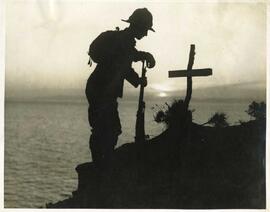HAMILTON, Gen Sir Ian Standish Monteith (1853-1947)
- HAMILTON, ISM
- Collection
- 1814-2015
Papers, 1814-2015, relating to Hamilton's life, military career and activities. The collection specifically includes correspondence, 1852-1899; diaries and notebooks, 1870-1899; printed correspondence and speeches of FM Frederick Sleigh Roberts, 1st Earl Roberts of Kandahar, Waterford and Pretoria, 1878-1893; diaries kept during the siege of Ladysmith, South Africa, 1899-1900; personal and official correspondence during the Second Boer War, 1899-1902, including Hamilton's letters to FM Frederick Sleigh Roberts, 1st Earl Roberts of Kandahar, Waterford and Pretoria, 1901-1902, and operational correspondence of 10 Div and Hamilton's Force, 1900; Hamilton's diaries of the Russo-Japanese War, 1904-1905 and related correspondence, 1902-1905; publications of the Royal Commissions on the war in South Africa and on the Militia and Volunteers, 1903-1904; correspondence as General Officer Commanding Southern Command, 1905-1909, and related official papers; correspondence as General Officer Commanding Mediterranean Command and Inspector General of Overseas Forces, 1910-1914, including papers relating to compulsory and voluntary military service, official reports on overseas forces, and correspondence relating to Hamilton's tours of the West Indies, South Africa, the Far East, Canada, Australia and New Zealand; correspondence as Commander-in-Chief Central Force, Home Defence, 1914-1915; papers as General Officer Commanding Mediterranean Expeditionary Force on Gallipoli, 1915, including correspondence with FM Horatio Herbert Kitchener, 1st Earl Kitchener of Khartoum and Broome, and the War Office, Rt Hon Winston Leonard Spencer Churchill MP, Lt Gen Sir John Grenfell Maxwell and Lt Gen Sir William Riddell Birdwood; papers relating to Ellis Ashmead Bartlett and Keith Arthur Murdoch, war correspondents on Gallipoli; papers relating to operations at Suvla Bay and Sari Bair, Aug-Sep 1915, and to the efficiency of commanding officers; papers relating to Hamilton's despatches from Gallipoli, and to recommendations for decorations; official despatches, 1914-1919; force orders, intelligence bulletins and other papers of General Headquarters, Mediterranean Expeditionary Force; papers relating to Hamilton's Gallipoli diary; maps and official photographs of the Gallipoli Campaign; depositions of witnesses given to the Dardanelles Commission, with related correspondence, 1916-1919; correspondence with the War Office, 1917-1938; correspondence as Colonel of the Gordon Highlanders, 1912-1949; correspondence relating to ex-servicemen, the British Legion, and to war memorials, 1916-1949; correspondence and papers as Lord Rector of Edinburgh University, 1932-1936; correspondence with major military, political and literary acquaintances, including Rt Hon Winston Leonard Spencer Churchill MP, Rt Hon Richard Burdon Haldane, 1st Viscount Haldane of Cloan, Capt Sir Basil Henry Liddell Hart, John Masefield, FM Sir William Robert Robertson, and senior officers associated with the Gallipoli Campaign, 1916-1949; correspondence relating to the Anglo-German Association and to Anglo-German relations, 1928-1947; correspondence with members of the public and relatives, 1908-1948; business and financial correspondence, 1913-1947; correspondence relating to Hamilton's estate and his literary executors, 1948-1969; papers relating to Hamilton's publications, 1872-1948; speeches, articles and letters to the press, 1918-1947; scrapbooks and press cuttings, 1883-1971; photographs, 1855-1947; publications and other printed material, 1814-1966; diaries, correspondence and publications of Hamilton's wife, Jean Miller Hamilton, Lady Hamilton, 1869-1940; correspondence of Eleanor Charlotte Sellar, 1896-1934, including correspondence with Hamilton, FM Sir George Stuart White and FM Sir Neville Bowles Chamberlain.
Hamilton, Sir Ian Standish Monteith, 1853-1947, Knight, General


